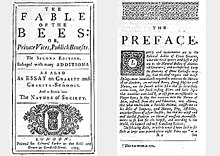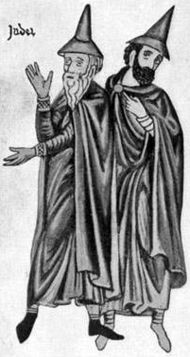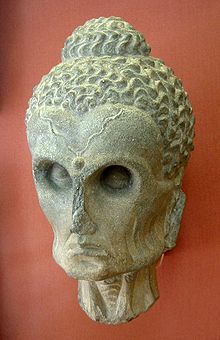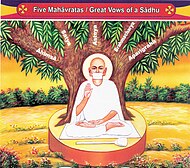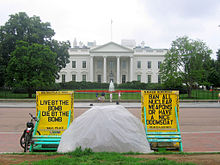An electronics store in a shopping mall in Jakarta (2004)
Consumerism is a social and economic order that encourages the acquisition of goods and services in ever-increasing amounts. With the industrial revolution, but particularly in the 20th century, mass production led to an economic crisis: there was overproduction — the supply of goods would grow beyond consumer demand, and so manufacturers turned to planned obsolescence and advertising to increase consumer spending. An early criticism of consumerism is Thorstein Veblen's best known book, The Theory of the Leisure Class from 1899, which critically examined newly widespread values and economic institutions emerging along with newly widespread "leisure time" at the turn of the 20th century. In it Veblen "views the activities and spending habits of this leisure class in terms of conspicuous and vicarious consumption and waste. Both are related to the display of status and not to functionality or usefulness."
In economics, consumerism may refer to economic policies which emphasise consumption. In an abstract sense, it is the consideration that the free choice of consumers should strongly orient the choice by manufacturers of what is produced and how, and therefore orient the economic organization of a society (compare producerism, especially in the British sense of the term). In this sense, consumerism expresses the idea not of "one man, one voice", but of "one dollar, one voice", which may or may not reflect the contribution of people to society.
In the almost complete absence of other sustained macro-political and social narratives — concern about global climate change notwithstanding — the pursuit of the 'good life' through practices of what is known as 'consumerism' has become one of the dominant global social forces, cutting across differences of religion, class, gender, ethnicity and nationality. It is the other side of the dominant ideology of market globalism and is central to what Manfred Steger calls the 'global imaginary'.
Term
The term consumerism has several definitions. These definitions may not be related to each other and confusingly, they conflict with each other.- One sense of the term relates to efforts to support consumers' interests. By the early 1970s it had become the accepted term for the field and began to be used in these ways:
- Consumerism is the concept that consumers should be informed decision makers in the marketplace. In this sense consumerism is the study and practice of matching consumers with trustworthy information, such as product testing reports.
- Consumerism is the concept that the marketplace itself is responsible for ensuring social justice through fair economic practices. Consumer protection policies and laws compel manufacturers to make products safe.
- Consumerism refers to the field of studying, regulating, or interacting with the marketplace. The consumer movement is the social movement which refers to all actions and all entities within the marketplace which give consideration to the consumer.
- While the above definitions were becoming established, other people began using the term consumerism to mean "high levels of consumption". This definition has gained popularity since the 1970s and began to be used in these ways:
- Consumerism is the selfish and frivolous collecting of products, or economic materialism. In this sense consumerism is negative and in opposition to positive lifestyles of anti-consumerism and simple living.
- Consumerism is a force from the marketplace which destroys individuality and harms society. It is related to globalization and in protest against this some people promote the "anti-globalization movement".
The term consumerism would pin the tag where it actually belongs — on Mr. Consumer, the real boss and beneficiary of the American system. It would pull the rug right out from under our unfriendly critics who have blasted away so long and loud at capitalism. Somehow, I just can't picture them shouting: "Down with the consumers!"Bugas's definition aligned with Austrian economics founder Carl Menger's vision (in his 1871 book Principles of Economics) of consumer sovereignty, whereby consumer preferences, valuations, and choices control the economy entirely (a concept directly opposed to the Marxian perception of the capitalist economy as a system of exploitation).
Vance Packard worked to change the meaning of the term consumerism from a positive word about consumer practices to a negative word meaning excessive materialism and waste. The ads for his 1960 book The Waste Makers prominently featured the word consumerism in a negative way.
History
Origins
The consumer society emerged in the late seventeenth century and intensified throughout the eighteenth century. While some claim that change was propelled by the growing middle-class who embraced new ideas about luxury consumption and the growing importance of fashion as an arbiter for purchasing rather than necessity, many critics argue that consumerism was a political and economic necessity for the reproduction of capitalist competition for markets and profits, while others point to the increasing political strength of international working class organizations during a rapid increase in technological productivity and decline in necessary scarcity as a catalyst to develop a consumer culture based on therapeutic entertainments, home ownership and debt. The more positive, middle-class view argues that this revolution encompassed the growth in construction of vast country estates specifically designed to cater for comfort and the increased availability of luxury goods aimed at a growing market. Such luxury goods included sugar, tobacco, tea and coffee; these were increasingly grown on vast plantations (historically by slave labor) in the Caribbean as demand steadily rose. In particular, sugar consumption in Britain during the course of the 18th century increased by a factor of 20.Critics argue that colonialism was indeed a driver of consumerism, but they would place the emphasis on the supply rather than the demand as the motivating factor. An increasing mass of exotic imports as well as domestic manufactures had to be consumed by the same number of people who had been consuming far less than was becoming necessary. Historically, the notion that high levels of consumption of consumer goods is the same thing as achieving success or even freedom did not precede large-scale capitalist production and colonial imports. That idea was produced later, more or less strategically, in order to intensify consumption domestically and make resistant cultures more flexible to extend its reach.
Culture of consumption
This pattern was particularly visible in London where the gentry and prosperous merchants took up residence and created a culture of luxury and consumption that was slowly extended across the socio-economic divide. Marketplaces expanded as shopping centres, such as the New Exchange, opened in 1609 by Robert Cecil in the Strand. Shops started to become important as places for Londoners to meet and socialise and became popular destinations alongside the theatre. Restoration London also saw the growth of luxury buildings as advertisements for social position with speculative architects like Nicholas Barbon and Lionel Cranfield.
There was growth in industries like glass making and silk manufacturing, and much pamphleteering of the time was devoted to justifying private vice for luxury goods for the greater public good. This then scandalous line of thought caused great controversy with the publication of Bernard Mandeville's influential work Fable of the Bees in 1714, in which he argued that a country's prosperity ultimately lay in the self-interest of the consumer.
Advertising plays a major role in creating a consumerist society, as goods are marketed through various platforms in nearly all aspects of life, pushing the message that the viewer's life is in need of some product. Consumerism is discussed in detail in the textbook Media in Everyday Life. The authors write, "Consumerism is deeply integrated into the daily life and the visual culture of the societies in which we live, often in ways that we do not even recognize" (Smulyan 266). She continues, "Thus even products that are sold as exemplifying tradition and heritage, such as Quaker Oats cereal, are marketed through constantly changing advertising messages" (Smulyan 266). Advertising changes with the consumer in order to keep up with their target, identifying their needs and their associations of brands and products before the viewer is consciously aware. Mediums through which individuals are exposed to ads is ever changing and ever growing, as marketers are always trying to get in touch with their audience, and adapts to ways to keep attention. For example, billboards were created around the time that the automobile became prevalent in society, and they were created to provide viewers with short details about a brand or a "catch phrase" that a driver could spot, recognize, and remember (Smulyan 273). In the 21st century there is an extreme focus on technology and digitization of culture. Much of the advertising is done in cohesive campaigns through various mediums that make ignoring company messages nearly impossible. Aram Sinnreich writes about the relationship between online advertisers and publishers and how it has been strengthened by the digitization of media, as consumer's data is always being collected through their online activity (Sinnreich 3). In this way, consumers are targeted based on their searches and bombarded with information about more goods and services that they may eventually need, positioning themselves as a need rather than a want.
Josiah Wedgwood's pottery, a status symbol of consumerism in the late 18th century
These trends were vastly accelerated in the 18th century, as rising prosperity and social mobility increased the number of people with disposable income for consumption. Important shifts included the marketing of goods for individuals as opposed to items for the household, and the new status of goods as status symbols, related to changes in fashion and desired for aesthetic appeal, as opposed to just their utility. The pottery inventor and entrepreneur, Josiah Wedgwood, noticed the way aristocratic fashions, themselves subject to periodic changes in direction, slowly filtered down through society. He pioneered the use of marketing techniques to influence and manipulate the direction of the prevailing tastes and preferences to cause his goods to be accepted among the aristocracy; it was only a matter of time before his goods were being rapidly bought up by the middle classes as well. His example was followed by other producers of a wide range of products and the spread and importance of consumption fashions became steadily more important.
Mass production
The Industrial Revolution dramatically increased the availability of consumer goods, although it was still primarily focused on the capital goods sector and industrial infrastructure (i.e., mining, steel, oil, transportation networks, communications networks, industrial cities, financial centers, etc.). The advent of the department store represented a paradigm shift in the experience of shopping. For the first time, customers could buy an astonishing variety of goods, all in one place, and shopping became a popular leisure activity. While previously the norm had been the scarcity of resources, the industrial era created an unprecedented economic situation. For the first time in history products were available in outstanding quantities, at outstandingly low prices, being thus available to virtually everyone in the industrialized West.By the turn of the 20th century the average worker in Western Europe or the United States still spent approximately 80–90% of his income on food and other necessities. What was needed to propel consumerism proper, was a system of mass production and consumption, exemplified in Henry Ford, the American car manufacturer. After observing the assembly lines in the meat packing industry, Frederick Winslow Taylor brought his theory of scientific management to the organization of the assembly line in other industries; this unleashed incredible productivity and reduced the costs of all commodities produced on assembly lines.
Black Friday shoppers, DC USA
Consumerism has long had intentional underpinnings, rather than just developing out of capitalism. As an example, Earnest Elmo Calkins noted to fellow advertising executives in 1932 that "consumer engineering must see to it that we use up the kind of goods we now merely use", while the domestic theorist Christine Frederick observed in 1929 that "the way to break the vicious deadlock of a low standard of living is to spend freely, and even waste creatively".
The older term and concept of "conspicuous consumption" originated at the turn of the 20th century in the writings of sociologist and economist, Thorstein Veblen. The term describes an apparently irrational and confounding form of economic behaviour. Veblen's scathing proposal that this unnecessary consumption is a form of status display is made in darkly humorous observations like the following:
| “ | It is true of dress in even a higher degree than of most other items of consumption, that people will undergo a very considerable degree of privation in the comforts or the necessaries of life in order to afford what is considered a decent amount of wasteful consumption; so that it is by no means an uncommon occurrence, in an inclement climate, for people to go ill clad in order to appear well dressed. | ” |
The term "conspicuous consumption" spread to describe consumerism in the United States in the 1960s, but was soon linked to debates about media theory, culture jamming, and its corollary productivism.
| “ | By 1920 most people [Americans] had experimented with occasional installment buying. | ” |
In the 21st century
Madeline Levine criticized what she saw as a large change in American culture — "a shift away from values of community, spirituality, and integrity, and toward competition, materialism and disconnection."
Businesses have realized that wealthy consumers are the most attractive targets of marketing. The upper class's tastes, lifestyles, and preferences trickle down to become the standard for all consumers. The not-so-wealthy consumers can "purchase something new that will speak of their place in the tradition of affluence". A consumer can have the instant gratification of purchasing an expensive item to improve social status.
Emulation is also a core component of 21st century consumerism. As a general trend, regular consumers seek to emulate those who are above them in the social hierarchy. The poor strive to imitate the wealthy and the wealthy imitate celebrities and other icons. The celebrity endorsement of products can be seen as evidence of the desire of modern consumers to purchase products partly or solely to emulate people of higher social status. This purchasing behavior may co-exist in the mind of a consumer with an image of oneself as being an individualist.
Cultural capital, the intangible social value of goods, is not solely generated by cultural pollution. Subcultures also manipulate the value and prevalence of certain commodities through the process of bricolage. Bricolage is the process by which mainstream products are adopted and transformed by subcultures. These items develop a function and meaning that differs from their corporate producer's intent. In many cases, commodities that have undergone bricolage often develop political meanings. For example, Doc Martens, originally marketed as workers boots, gained popularity with the punk movement and AIDs activism groups and became symbols of an individual's place in that social group. When corporate America recognized the growing popularity of Doc Martens they underwent another change in cultural meaning through counter-bricolage. The widespread sale and marketing of Doc Martens brought the boots back into the mainstream. While corporate America reaped the ever-growing profits of the increasingly expensive boot and those modeled after its style, Doc Martens lost their original political association. Mainstream consumers used Doc Martens and similar items to create an "individualized" sense identity by appropriating statement items from subcultures they admired.
When consumerism is considered as a movement to improve rights and powers of buyers in relation to sellers, there are certain traditional rights and powers of sellers and buyers.[28]
Criticism
Overview
Buy Nothing Day demonstration in San Francisco, November 2000.
Shop Until You Drop by Banksy, in London.
Since consumerism began, various individuals and groups have consciously sought an alternative lifestyle. These movements range on a spectrum from moderate "simple living", "eco-conscious shopping", and "localvore"/"buying local", to Freeganism on the extreme end. Building on these movements, the discipline of ecological economics addresses the macro-economic, social and ecological implications of a primarily consumer-driven economy.
In many critical contexts, consumerism is used to describe the tendency of people to identify strongly with products or services they consume, especially those with commercial brand-names and perceived status-symbolism appeal, e.g. a luxury car, designer clothing, or expensive jewelry. Consumerism can take extreme forms - such that consumers sacrifice significant time and income not only to purchase but also to actively support a certain firm or brand.
Opponents of consumerism argue that many luxuries and unnecessary consumer-products may act as a social mechanism allowing people to identify like-minded individuals through the display of similar products, again utilizing aspects of status-symbolism to judge socioeconomic status and social stratification. Some people believe relationships with a product or brand name are substitutes for healthy human relationships lacking in societies, and along with consumerism, create a cultural hegemony, and are part of a general process of social control in modern society. Critics of consumerism often point out that consumerist societies are more prone to damage the environment, to contribute to global warming and to use up resources at a higher rate than other societies. Dr. Jorge Majfud says that "Trying to reduce environmental pollution without reducing consumerism is like combatting drug trafficking without reducing the drug addiction."
In 1955, economist Victor Lebow stated:
| “ | Our enormously productive economy demands that we make consumption our way of life, that we convert the buying and use of goods into rituals, that we seek our spiritual satisfaction and our ego satisfaction in consumption. We need things consumed, burned up, worn out, replaced and discarded at an ever-increasing rate. | ” |
Critics of consumerism include Pope Emeritus Benedict XVI, German historian Oswald Spengler (1880-1936), who said: "Life in America is exclusively economic in structure and lacks depth"), and French writer Georges Duhamel (1884-1966), who held American materialism up as "a beacon of mediocrity that threatened to eclipse French civilization". Francis Fukuyama blames consumerism for moral compromises.
In an opinion segment of New Scientist magazine published in August 2009, reporter Andy Coghlan cited William Rees of the University of British Columbia and epidemiologist Warren Hern of the University of Colorado at Boulder saying that human beings, despite considering themselves civilized thinkers, are "subconsciously still driven by an impulse for survival, domination and expansion ... an impulse which now finds expression in the idea that inexorable economic growth is the answer to everything, and, given time, will redress all the world's existing inequalities." According to figures presented by Rees at the annual meeting of the Ecological Society of America, human society is in a "global overshoot", consuming 30% more material than is sustainable from the world's resources. Rees went on to state that at present, 85 countries are exceeding their domestic "bio-capacities", and compensate for their lack of local material by depleting the stocks of other countries, which have a material surplus due to their lower consumption. Not only that, but McCraken indicates that the ways in which consumer goods and services are bought, created and used should be taken under consideration when studying consumption.
Furthermore, some theorists have concerns with the place commodity takes in the definition of one's self. Media theorists Straut Ewen coined the term "commodity self" to describe an identity built by the goods we consume. For example, people often identify as PC or Mac users, or define themselves as a Coke drinker rather than Pepsi. The ability to choose one product out of an apparent mass of others allows a person to build a sense "unique" individuality, despite the prevalence of Mac users or the nearly identical tastes of Coke and Pepsi. By owning a product from a certain brand, one's ownership becomes a vehicle of presenting an identity that is associated with the attitude of the brand. The idea of individual choice is exploited by corporations that claim to sell "uniqueness" and the building blocks of an identity. The invention of the commodity self is a driving force of consumerist societies, preying upon the deep human need to build a sense of self.
Not all anti-consumerists oppose consumption in itself, but they argue against increasing the consumption of resources beyond what is environmentally sustainable. Jonathan Porritt writes that consumers are often unaware of the negative environmental impacts of producing many modern goods and services, and that the extensive advertising-industry only serves to reinforce increasing consumption. Likewise, other ecological economists such as Herman Daly and Tim Jackson recognize the inherent conflict between consumer-driven consumption and planet-wide ecological degradation.
Consumerism as cultural ideology
In the 21st century's globalized economy, consumerism has become a noticeable part of the culture. Critics of the phenomenon not only criticized it against what is environmentally sustainable, but also the spread of consumerism in cultural aspects. Leslie Sklair proposes the criticism through the idea of culture-ideology of consumerism in his works. He says that,First, capitalism entered a qualitatively new globalizing phase in the 1950s. As the electronic revolution got underway, significant changes began to occur in the productivity of capitalist factories, systems of extraction and processing of raw materials, product design, marketing and distribution of goods and services. […] Second, the technical and social relations that structured the mass media all over the world made it very easy for new consumerist lifestyles to become the dominant motif for these media, which became in time extraordinarily efficient vehicles for the broadcasting of the culture-ideology of consumerism globally.As of today, people are exposed to mass consumerism and product placement in the media or even in their daily lives. The line between information, entertainment, and promotion of products has been blurred so people are more reformulated into consumerist behaviour. Shopping centers are a representative example of a place where people are explicitly exposed to an environment that welcomes and encourages consumption as some of them are open for 24 hours. Goss says that the shopping center designers "strive to present an alternative rationale for the shopping center's existence, manipulate shoppers' behavior through the configuration of space, and consciously design a symbolic landscape that provokes associative moods and dispositions in the shopper".
The success of the consumerist cultural ideology can be witnessed all around the world. People rush to the mall to buy products and end up spending money with their credit cards, thus locking themselves into the financial system of capitalist globalization.

